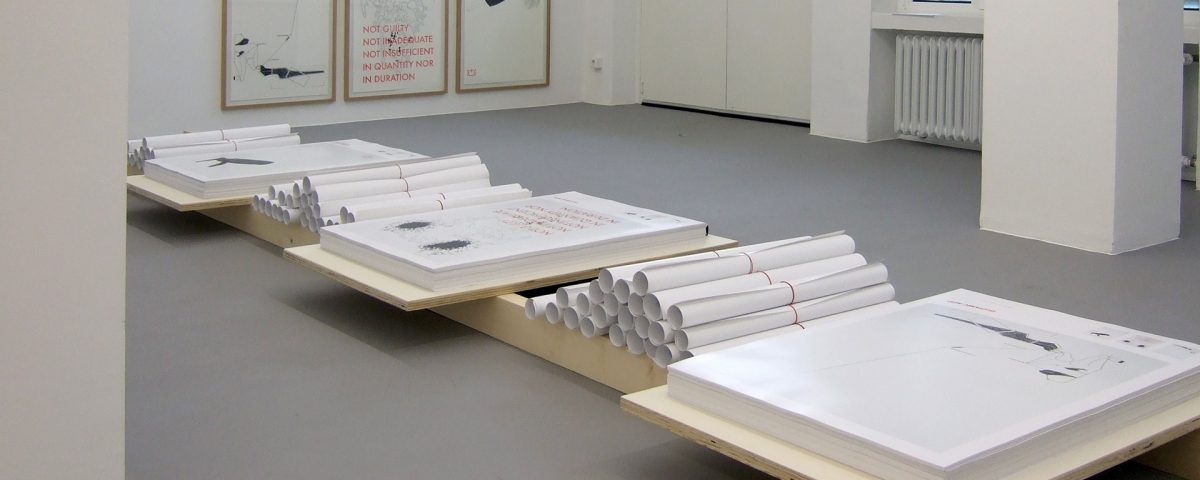
CATHARINA VAN EETVELDE
19/03/–30/04/2010
Belgian artist Catharina van Eetvelde insistently, and simultaneously, explores the expressive potential and sparing economy of the line in compositions which hold the two aspects in such tension that it sometimes seems her drawings pulse on the page. In series like the articulated particle, zone a and zone b (2004), or Whether Water is Held Responsible (2006), the eye and mind work across the individual drawings to assemble abstracted organic and mechanical shapes (some recalling circuitry, others bringing to mind basic or more elaborate life forms), architectural structures, cellular cross-sections, mysterious tools, and invented creatures. Looking at them as a group feels much like reading a beautiful sentence made up of words that do not cohere into some linear master message. However, Van Eetvelde is not deliberately cryptic. Rather, she employs the discreet, yet certain, repetition of a gesture, color, shape or stroke in order to subtly jog our memory of a thing already seen or to forecast a page still to be encountered. The resulting narrative threads flit in and out of perception and feel productively paradoxical, as if they were formed from the oxymorons of controlled free-association or reigned-in spontaneity.
Fascinated by the relationship between drawing and language, van Eetvelde does not simply put these drawings on paper into motion in her animations (Slice 2004-5, Cruise, 2002-03, Whether Water is Held Responsible, 2006, and Glu, 2007, for Art Positions, Art Basel Miami Beach), she devises an entirely new syntax out of a confrontation between the two processes. Whereas time and motion play an incontestably important role in her works on paper, animation allows van Eetvelde to incorporate temporal and physical transformations, compositions and decompositions, or happy accidents, in ways that only the moving image allows.
If drawing maintains its historical status as the fundamental building-block of representation in our increasingly digitized world, van Eetvelde’s approach to the medium capitalizes on its full mechanical and technological potential today. Formally innovative and utterly contemporary, a work like Cruise, for which she collaborated with writer Abigail Lang, poetically engages with issues of globalization and shifting geographies: over one thousand animated drawings of nautical maps, outlines of countries, including her native Belgium, New Zealand, and the Holy See, meld with colorful territorial markers that flow across a vectored surface like cruise ships crossing the Ocean. In Glu, her project for Art Positions at Art Basel Miami Beach, Van Eetvelde pursues her investigation of the interface between the drawn and moving image, this time, by activating a female character, who will repeatedly undergo a series of transformations. What at first seems random is in fact structured like a song, with her familiar fragmentary cellular/circuit imagery serves as a refrain breaking the sequences. The hypnotic soundtrack (by the Berlin based electronic group to rococo rot) combines staccato beats, blips, and seductive bass and strings that magically marry themselves to the girl’s movements. Like all enchanting figures, she captures our gaze and draws us in as we anticipate what might happen to her next. But Glu also stages the act of being watched, as a pair of pixellized red eyes projected on the adjacent wall consider the whole scene with interest.
By taking into account the considerable promise of her chosen medium, Van Eetvelde’s displays help render the complexity of her processes. Her experimental exhibition displays vary in scale and format, incorporating more conventionally framed and unframed drawings of different sizes, or grouped identical sheets of weighty cotton and linen paper (and en et, 2002-3), along with more playful modes of presentation like the flip-book (166 samples from slice, 2005), and experiments with installations, flat-screens, or projections for her drawn animations. Each presentation demands a different form of awareness and attention on the part of the viewer: the intimate experience of looking at or handling her works on paper contrasts sharply with the more collective occasion of an animated projection involving spoken words or music, where the visual and the verbal, sight and sound feed into and reflect off each other to provide rhythm. Glu capitalizes on this principle. Though conceived as a single work, Glu is a dual channel projection (Glu black and Glu red), which takes full advantage of the specific dimensions and characteristics of the shipping container and its setting. Glu captivates the visitor by transforming its interior into a fully sensorial experience incorporating line, light, narrative, and music that is thoroughly in keeping with the cutting-edge atmosphere of Art Positions.
Vivian Rehberg
